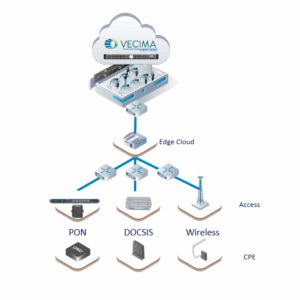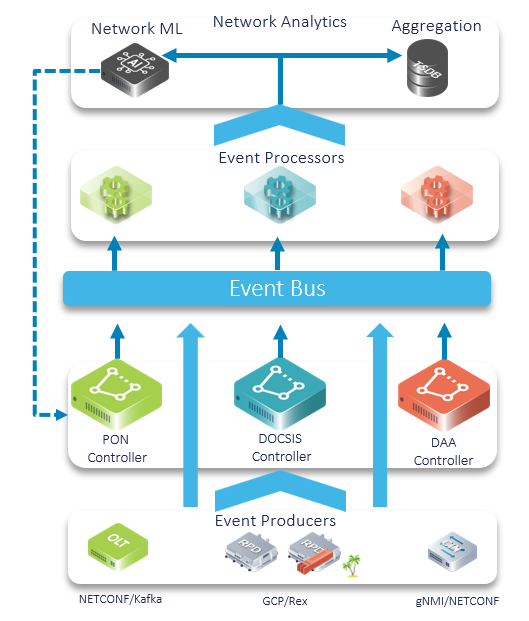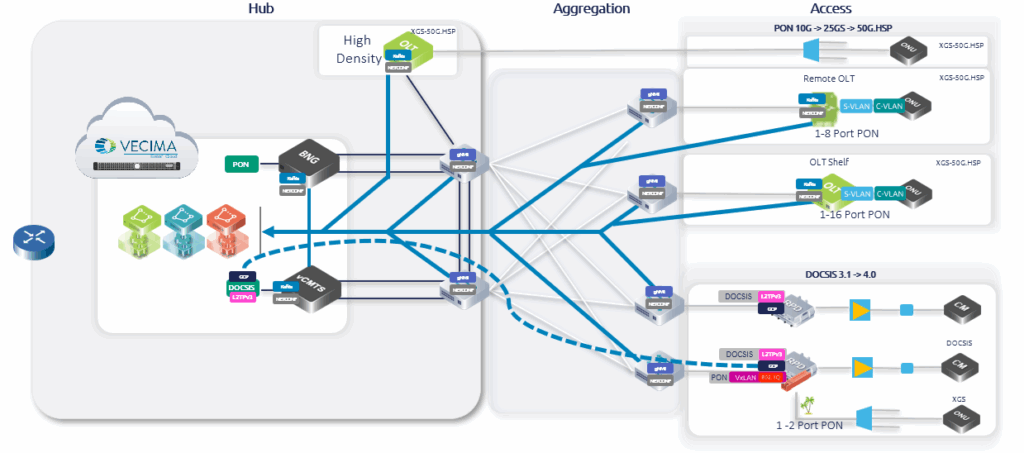
Broadband networks are expanding across DOCSIS®, PON, and wireless technologies. That complexity is outpacing legacy monitoring models. The only way forward is converged telemetry—AI-driven, real-time visibility that keeps pace with demand. But AI can’t deliver results without access to the right data.
Converged telemetry is mission-critical, providing real-time visibility and intelligence that operators need to manage complexity, spot issues early, and act with precision.
Align Access Technologies Under a Unified Operational Model
In practical terms, convergence means shifting from technology-centric provisioning to service-centric delivery. It’s no longer enough to monitor and manage DOCSIS separately from PON, or to build entirely distinct systems for residential, business, and wireless access. Instead, converged networks aim to treat all access domains as interchangeable pathways for delivering the same services.
That model depends on virtualization. Operators are now deploying cloud-native environments that support DOCSIS, PON, and wireless workloads on shared compute resources. With this structure in place, they could be deploying virtual cable modem termination systems (CMTSs) and virtual broadband network gateway (vBNG) instances as needed, scaling them independently while still tying everything into the same orchestration and analytics frameworks.
For this model to work, telemetry must also be converged. A unified infrastructure is only as manageable as the data it produces. Operators can no longer afford to view telemetry through separate DOCSIS and PON lenses. Instead, they need consistent service-level visibility that reflects how the entire access environment is performing, regardless of which technology a customer uses.
Define What Telemetry Must Deliver
If convergence is the architectural goal, then telemetry is what makes the infrastructure operable at scale. In a converged access environment, telemetry isn’t just a support system – it’s a core function. It allows operators to measure availability and performance, assure quality, and detect problems early across any access technology.
To get there, operators must understand their goals for telemetry in a converged environment. The most urgent of these are measuring reliability, identifying performance degradations, and mapping those back to user experience. Operators need actionable key performance indicators (KPIs) – ones that tell them how a service is performing rather than how a specific interface or device is behaving.
That starts with the access domain. In DOCSIS networks, for example, operators might track orthogonal frequency-division multiple access (OFDMA) receive modulation error ratio (MER), uncorrectable codeword counts, or ingress levels. On the fiber side, they’re looking at physical-layer link metrics from OLTs and optical network units (ONUs). But regardless of the technology, those domain-level metrics must roll up into service-level insights. It’s not enough to know that a link is error-free or the radio frequency (RF) spectrum is stable. The bigger question is whether the customer’s video stream is smooth or if latency-sensitive applications are suffering.
Telemetry must reflect what matters most to subscribers. As a result, that means moving past traditional monitoring systems that focus on device health and toward a model that connects network events to service performance in real time.
Connect Telemetry to Automation
Getting telemetry right requires reducing manual operations. The long-term goal is to close the loop between monitoring and action. AI and machine learning can help, but they’re only as effective as the data they’re fed. Operators need structured, high-quality telemetry across all access domains to support predictive maintenance, root cause analysis, and automated decision-making.
Initially, that automation might still involve a human in the loop who will gain insights and recommended actions for review. As confidence in the system grows, operators can move toward autonomous remediation of faults and adjustments to service configurations. The key is consistency. Operators must standardize telemetry across DOCSIS, PON, and any other access methods. As a result, that consistency ensures they evaluate service performance the same way across technologies – and trigger the right operational response every time.
This is especially critical in converged environments. With DOCSIS and PON often operating side by side – and sometimes over shared backhaul or physical infrastructure – the telemetry model must support fast, coordinated responses to avoid service degradation.
Build a Pipeline That Scales With Complexity
So what does a modern telemetry pipeline look like? It’s a flow that starts at the network edge and ends in the analytics engine. Telemetry originates from devices across the access network, such as virtual CMTSs, ONUs, and OLTs. These devices stream telemetry data into their respective DOCSIS and PON controllers before passing it to an event bus like Apache Kafka.
At that point, the telemetry enters the processing layer, where it must be filtered, correlated, and normalized. As a notable example, the Vecima Entra vCMTS has over 400,000 individual metrics available to internal developers. Clearly, no operator can – or should – monitor all of them directly. The system must evaluate the KPIs that matter while suppressing noise.
From there, two things happen. First, the telemetry is stored in a time-series database, enabling long-term trend analysis and historical performance tracking. Second, it’s routed into analytics engines that correlate metrics across devices and domains to surface service-level insights. These engines might trigger alerts, suggest changes, or – eventually – initiate automated responses.
Measure Service Quality in the Moment
As operators transition away from legacy polling mechanisms, they’re moving toward active service telemetry that reflects real-time subscriber experiences. Rather than sampling every 15 minutes, modern telemetry systems can identify issues and respond in seconds. That shift is critical for break-fix scenarios, performance optimization, and adaptive service provisioning. The faster the telemetry flows and the more contextual it is, the more precise the operational response can be. Therefore, operators gain the ability to triage and resolve issues efficiently, often before subscribers are aware of problems.
Process Where It Makes Sense
As networks become increasingly distributed, so too must telemetry processing. A layered approach mirrors modern access networks:
- At the subscriber edge, telemetry is sampled at high speed to identify local issues – typically in seconds. This is where active service telemetry lives, identifying events from ONUs, modems, and other customer-premises equipment.
- At the access edge, data is aggregated and lightly correlated, often in regional nodes or hub sites. Some processing can happen at the access edge, depending on the operator’s architecture.
- At the core or data center, telemetry is stored and analyzed at scale. This is where operators can apply long-term trend analysis, run training data for AI models, and perform deep correlation across thousands of nodes.
This layered approach balances real-time responsiveness with long-term intelligence.
Convergence Only Works If You Can See It
The future of broadband access is converged by design and intelligent by necessity. Operators are no longer running only DOCSIS or PON. They’re using both, often in parallel, with shared infrastructure, compute, and orchestration. Legacy monitoring systems can’t manage that amount of complexity.
Converged telemetry provides the visibility, context, and intelligence required to make these networks operable and to prepare them for increasing automation. With a robust telemetry pipeline in place, operators can shift from reacting to problems to preventing them. Furthermore, they can deliver consistent service experiences, even as access technologies evolve. And they can put AI to work in ways that improve reliability, performance, and customer satisfaction.
In short, without telemetry, convergence is a theory. With it, it becomes reality.
Experience Vecima’s path to next-generation networks.
Vecima’s network solutions deliver the scalability, reliability, and throughput required for a DOCSIS® 4.0, XGS-PON, 50G and beyond. See our broadband and video solutions at:
- SCTE TechExpo, September 29-October 1, in Washington, D.C., Booth A132
- Network X, October 14-16, in Paris, Meeting Room MR-19
Back to all resources
Get Started with Vecima
We help our customers evolve their networks with cloud-based solutions that deliver ground-breaking speed, superior video quality, and exciting new services to their subscribers.
Contact Us




